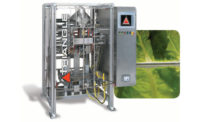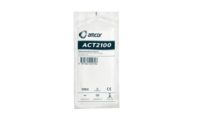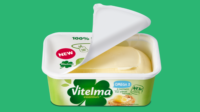Cold seal adhesives (a.k.a. self-seal adhesives) and heat seal adhesives are used in a variety of flexible packaging applications. While both coatings are frequently used in the packaging of food products and medical devices, each seal type comes with a different set of advantages and disadvantages. Determining the right coating for a particular product depends on a number of variables, primarily the specific needs and requirements of the item, such as machine speed and capacity, barrier properties (e.g. moisture, oxygen, UV light) and seal strength.
The technology for cold seal adhesives dates back many years. Cold seal packaging typically uses a combination of rubber, resins, plasticizers, extenders and other additives to form an adhesive bond between each substrate used in flexible packaging. In commercial packaging, the numbers of layers involved can range from two to as many as twelve or more.
With this process, cold seal adhesives are coated onto plastic films or other substrates to form layers that bond strongly to themselves when pressure is applied. The adhesive is applied wet to the substrate by a revolving gravure cylinder, and then immediately dried in an extended oven before it is reeled up at the end of the press. The adhesive is usually applied in the form of a distinct patter that allows the seal to be created without the application of heat. Recent technology involves the use of copolymers of vinyl acetate and ethylene combined with rubber latex. In some cases, these copolymers can be used without natural rubber latex.
Suitable for use on a variety of films and other substrates, cold seal applications include packaging for confectionary products; temperature sensitive products such as chocolate, candy bars, ice cream (bars or cups), cereal bars and other confections; horizontal form, fill and seal packaging; medical packaging such as bandages; temperature sensitive filling goods; and both mono-web and laminate structures for flow packaging.
The uniqueness of cold seal adhesives is that they seal only to themselves. When a substrate coated with a cold seal adhesive comes into contact with another substrate coated with the same cold seal adhesive, a strong bond results using simple digital pressure. That’s why the modifier “self-seal” is often used interchangeably with “cold seal.” Cold seal adhesives are different from other pressure sensitive adhesives, which are permanently tacky and must have a release paper covering to prevent adhering to other surfaces until final use.
The strength of the bond with cold seal technology varies depending on the particular adhesive formulation used. Manufacturers design these products with different bond strengths, from low to high, depending on the specifications of the application and packaging.
The primary advantage of cold seal technology is speed. The cold seal process can be as much as 10 times faster than heat seal packaging. For manufacturers, processing time with cold seal adhesives is faster because the production lines don’t have to wait for the heat to generate at startup. If the production line stops for any reason, heat sensitive products are not damaged, thereby preventing waste and associated losses. The absence of heat also eliminates burn injuries, providing a safer working environment for employees. Involving only pressure, the cold seal process does not take much time. Additional benefits of the cold seal approach include increased line speeds, decreased waste, stronger seals, better moisture resistance, easier unwind releases and minimal cling.
The primary disadvantage of the cold seal option is the lack of chemical resistance and other properties that may be required by the FDA depending on the type of product. Cold seal adhesives are also sensitive to air contact and require a suitable release surface.
The alternative to cold seal is heat seal packaging. Heat seal packaging usually consists of a multi-layered film that includes:
- an outer coating to prevent the film from melting,
- a core layer such as polypropylene and
- an interior sealant layer.
Heat sealing is the most commonly used form of package sealing technology — and when high-integrity seals are required, heat seal films are typically the preferred choice.
Heat sealing is a bit of a misnomer in that the bond is not created until the structure solidifies during the cooling phase of the process. Continued pressure application during the cooling process provides control over the package and ensures a seal of good appearance and high integrity. A dependable seal cannot be made without residual pressure to hold the seal in place during cooling.
Heat seal packaging doesn’t require any special processes or materials (such as pressure sensitive adhesives) and is therefore considered to be more economical than cold seal films. Available in a wide range of laminations, heat seal films also offer a wider variety of performance characteristics such as barrier properties that can be optimized to meet the specific needs of each product.
To ensure an effective heat seal, the following three factors must be carefully managed:
- Heat: the temperature of the sealing surfaces
- Dwell: the amount of time the jaws of a machine are in contact with the sealing material
- Pressure: the amount of pressure applied by heat seal machinery
When a change is made in any one of these factors, the other two must be adjusted to compensate. An increase in machine speed, for instance, requires a decrease in dwell time and an increase in temperature (and, in some cases, pressure). Accordingly, the overall success of the heat seal process depends on a manufacturer’s understanding of the specific procedures, methods and materials required for achieving a quality seal.
With respect to testing, it is important to note that seal strength does not necessarily equate to seal integrity. That’s because standardized strength tests do not cover other important performance characteristics such as oxygen, moisture or microbial barriers. Heat seal bags and pouches can be tested for pull strength, seal permeability, burst strength, vacuum strength and the ability to maintain a seal under sterilization procedures. Seal integrity can be tested in a number of ways and the rigor of the test depends on the specific requirements of the product and/or industry.
Heat sealing is used for joining thermoplastic films, typically less than 0.5 mm thick. There are two main types of heat sealing: hot-bar welding and impulse welding. Hot-bar welding and impulse welding are used for a variety of applications but are most widely used in the packaging industry for sealing bags, films and containers made from thermoplastics. This includes flexible pouches and bags, as well as tray and bowl sealing for food packaging.
Polymer producers are also making new plastics with superior performance characteristics for production, protection and display. Many of the newer polymeric structures provide greater precision in the sealing process to ensure package integrity and tamper-evidence. At the end of the day, the objective is to produce high-integrity seals on production lines operating at maximum speed.
As packaging technologies and consumer demand continue to evolve hand-in-hand, new innovations in both cold seal and hot seal packaging continue to emerge. Today’s consumers are clamoring for convenience, freshness and taste, which is why many recent pouch innovations include features such as easy opening, dispensing or resealing. Convenience also accounts for the increased variety of sizes in flexible packaging, as well as on-the-go technology. Innovation in the area of active and intelligent packaging — which can add significant value to brands by providing a different consumer experience — is also on the rise.
Active and intelligent packaging can extend shelf life, monitors freshness, displays information on quality and can improve safety and convenience while giving consumers additional information about a product’s benefits. At this point, active and intelligent packaging is most commonly used on higher value products, such as pharmaceuticals, spirits and certain foods. The emerging technologies — including QR codes, augmented reality, near-field communications, temperature indicators and others — can connect the physical product with the digital world.
Across many areas, suppliers are making innovative advances that continue to propel pouches as the fastest-growing packaging segment. Many of these developments are in response to the demand for more convenience, while at the same time balancing the desire for more sustainable solutions. Brands are also focusing on improving their branding, controlling rising costs and maintaining operational efficiency.
Recent innovations range from the use of single polymers in pouches to the addition of active and intelligent capabilities, such as near-field communications (NFC) and augmented reality (AR). Suppliers are clearly edging forward, adding new features and benefits that enhance the value of flexible packaging.
According to David Luttenberger, global packaging director for market intelligence agency Mintel, the flexible packaging industry is moving swiftly to the challenges of packaging waste. “We’re beginning to see a lot of new innovation and research in the flexibles area,” says Luttenberger. He says he anticipates developments for more sustainable flexible packaging several areas, including:
- Higher recycled content
- Different types of laminations without adhesives
- Developments in barrier properties and compatiblizers
- Further work toward making flexibles more recyclable
- Multi-layer, mono-material flexibles that are more easily recyclable
Case in point, global packaging giant Sonoco recently launched a new line of more sustainable packaging options called EnviroSense packaging. The EnviroSense solutions include substrates of all types, including a recyclable polyethylene package called the EnviroFlex PE pouch. Ideal for a wide range of foods, from confections, dry and dehydrated foods to produce, the EnviroFlex PE pouch is eligible to apply for the How2Recycle Store Drop-Off label, which means it can be dropped off (clean and dray) at local retail stores for recycling along with grocery bags. The EnviroFlex PE pouch runs on both vertical and horizontal form-fill-seal machines and is available as a premade pouch with or without barrier properties.
Christina Cvetan, a partner and co-founder at Ahead of the Curve group, also expects to see positive movement in active and intelligent packaging, technology which can significantly enhance the customer experience. Active and intelligent packaging, for instance, can extend shelf life, monitor freshness, display information on quality, improve safety and convenience, and provide consumers with additional information about product benefits. Cvetan says brands are starting to use these technologies to emphasize more progressive messages like social purpose.
Luttenberger, a jurist for the 2019 Packaging Innovation Awards, says one development that will drive these new advances is greater collaboration within the industry. “It’s when brands come together to share resources and technologies that everyone benefits more quickly and in a greater way.”



